Unworldly Sea Snails That Look Like They Belong On Another Planet
When it comes to the natural world, we have explored the furthest lengths and breadths of snow-covered mountains and lush green fields. We have taken to the skies, which is the exclusive playing field and highway of birds for so long. Through our travels and exploits, we have experienced and witnessed the wonder of nature and its creations. While we have traveled through the lands and soared the skies, one domain of nature we have yet to explore fully. That being the great open oceans, of which 80% is still unknown and unexplored, hiding some genuinely amazing animals within their depths, such as these bizarre and incredible species of sea snails that you wouldn’t be wrong in thinking were aliens!
Dirona Albolineata
Dirona Albonlieata — you’re going to have to bear with us, and some of these super scientific names, they just don’t have any others — is our first guest. It is a nudibranch sea slug commonly found in the Eastern Pacific.
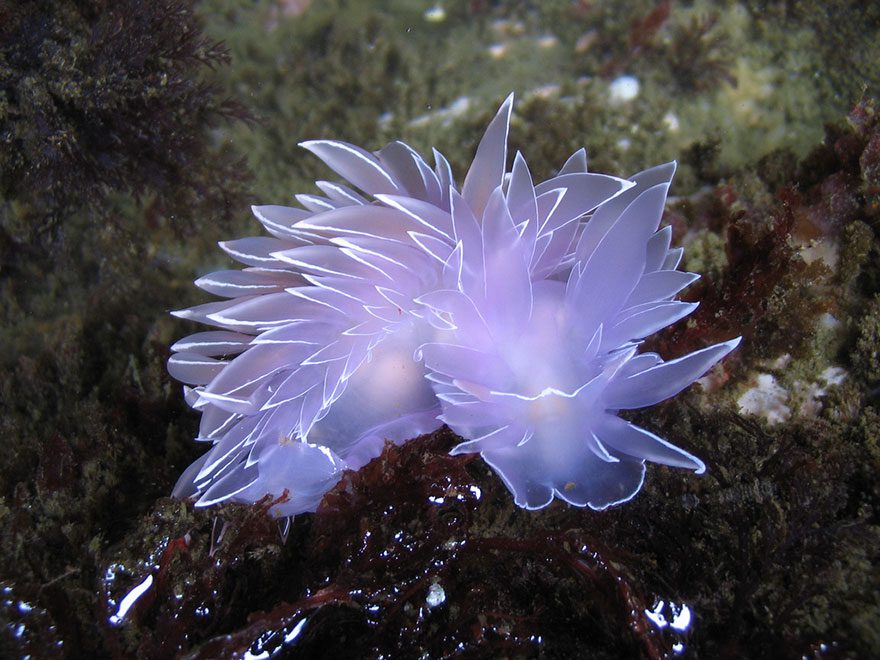
The name nudibranch refers to the family this little guy is from; they are known for their vibrant and colorful bodies. The albonlineata is a carnivorous species that feeds on tiny crustaceans, other snails, fungi, and algae (technically not plants; who knew?)!
Cyerce Nigricans
The Cyerce nigricans, another sacoglossan that is just as captivating to look at! Located within the Indian and Pacific Oceans, the nigricans are a rule-breaker due to their dark black coloration, unlike most other Cyerces, which are vibrant and bright.
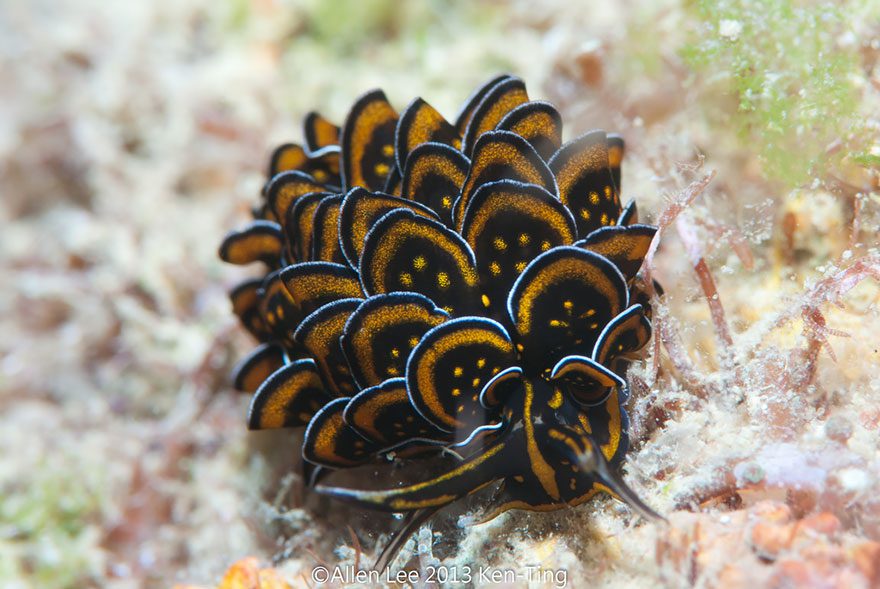
The mix of black and dark yellows/oranges sometimes makes the nigricans look like some weird mutant ladybug cousin. It is said that they can secrete an awful tasting substance that biologists believe acts as a defence mechanism against their predators.
Janolus Fuscus
The Janolus fuscus is nothing if not a statement maker, looking like a mix between an odd pincushion and a moving party light. The fuscus is another nudibranch that is commonly found around the Kenai Peninsula and parts of northern Japan.
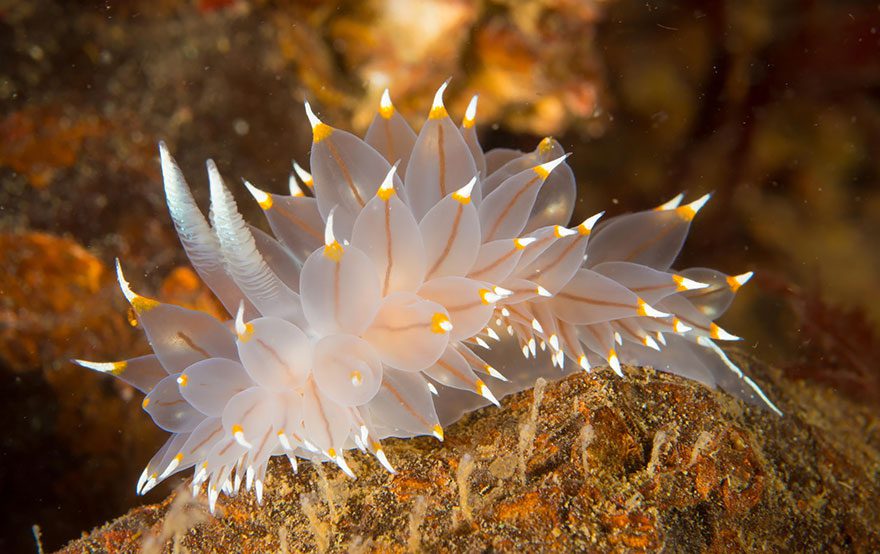
The fuscus has a semi-translucent body that adds to its striking appearance. Those long and bulbous tendrils you see are called cerata which act as a respiration aid as well as a defense mechanism or extra appendage in some species.
Flabellinopsis Iodinea – The Spanish Shawl
The fabulous looking Flabellinopsis iodinea is a highly vibrant aeolid nudibranch affectionately known as the Spanish shawl and is found on the western coast of northern America. It is similar to other nudibranchs, only that its cerata are capable of stinging!
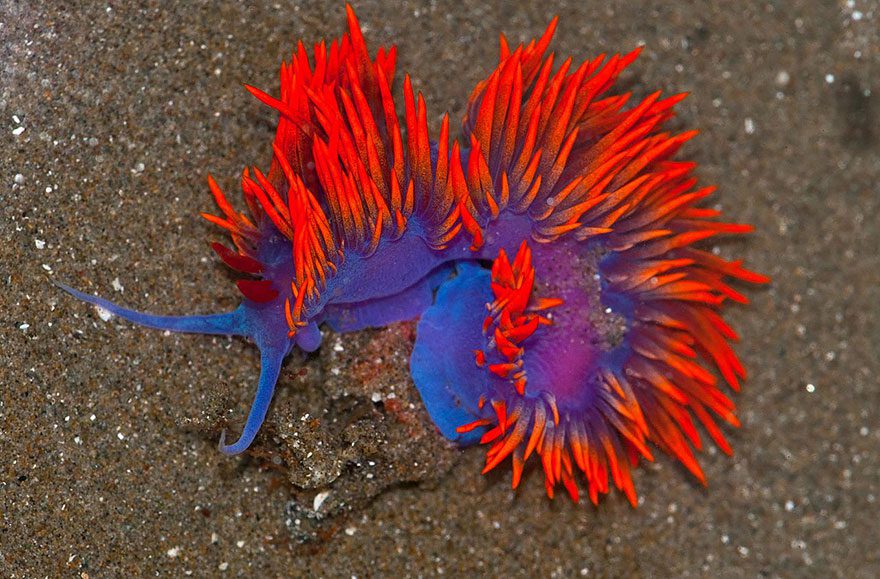
But the shawl’s cerata natively do not have any stinging cells. Instead, it gains the ability to deliver poisonous jabs by eating naturally stinging prey (like jellyfish and siphonophores) and incorporating the pry’s cells into itself to use for defense.
Phyllodesmium Poindimiei
Now the Phyllodesmium poindimiei definitely looks like some alien experiment where they tried to create an octopus worm hybrid. The poindimiei is native to tropical regions, such as waters around Hawaii and the Indo-pacific and is also an aeolid nudibranch.
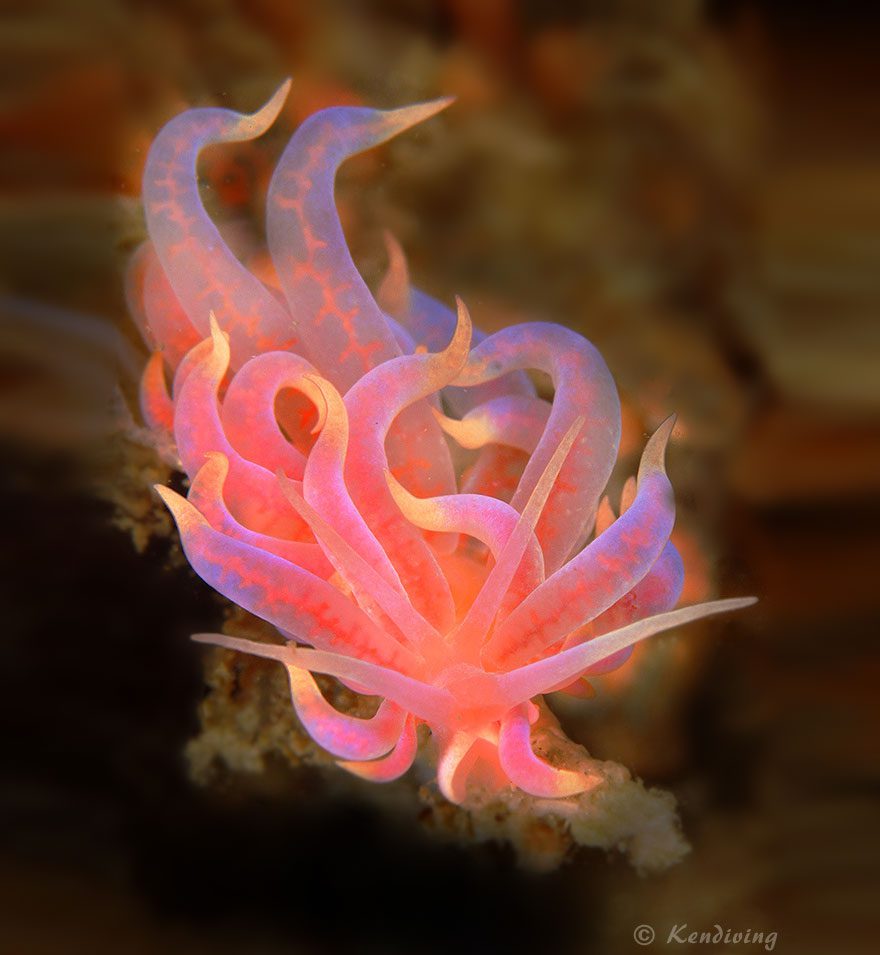
The cerata of the poindimiei are also used for defence purposes as well as to aid their metabolism. The poindimiei feeds on Alcyonacea, which refers to soft corals with more of a fleshier body than other corals. It’s beautiful too!
Cadlinella Ornatissima
Joining his fellow dorid nudibranch, we have the Cadlinella ornatissima, a cute but prickly looking little guy. The ornatissima makes its home around the coasts of north-eastern Australia (to a lesser extent) but is mainly found within the central Indo-Pacific region.
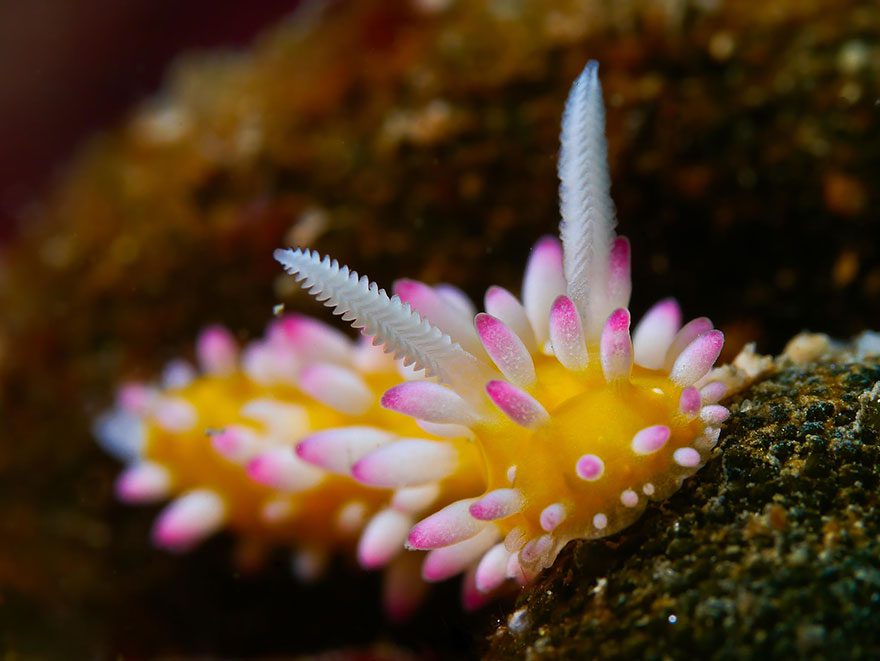
The tiny and cute pink-tipped tubes are the ornatissima’s most recognizable feature, which isn’t a surprise seeing as they are part of the Chromodorididae family of sea slugs, a family known for an astounding range of colors and distinct patterns.
Acanthodoris Pilosa
This adorable guy is named the Acanthodoris pilosa, sometimes incorrectly referred to as the “sea bunny,” and you can see why. It is incorrect because that name actually belongs to the Jorunna parva, a fellow dorid nudibranch from a different family.
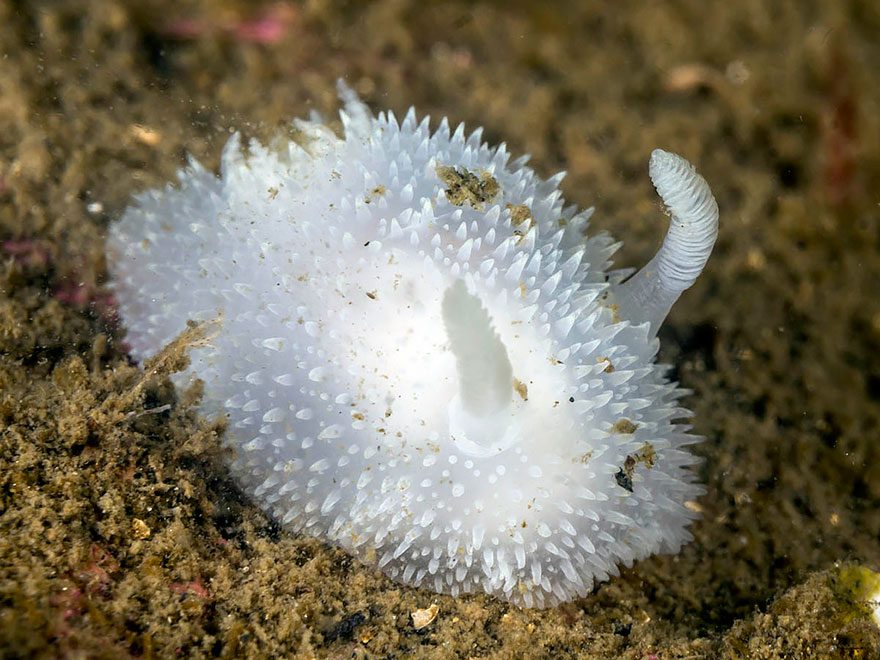
You can find the pilosa swimming along the north-eastern waters of the Atlantic Ocean and parts of the Pacific coast. They measure about 3cm in length and are covered in tiny bumps that give these creatures that fluffy look.
Hypselodoris Kanga
What do we have here? This colorful wanderer is known as the Hypselodoris kanga, a dorid nudibranch from just about everywhere, from Tanzania to Mozambique, to the Indian Ocean. The kanga can reach lengths of 70mm and likes to eat sea sponges!
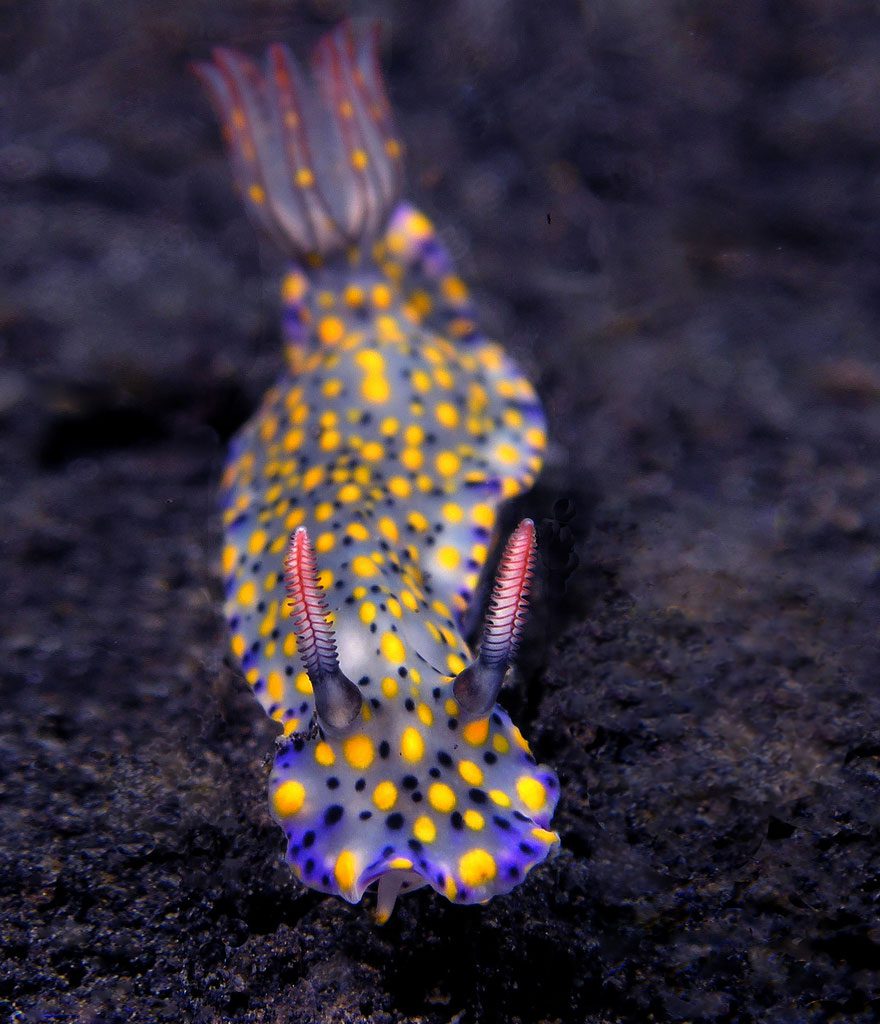
But what really makes the kanga remarkable is its skin, which ranges from tones of blues and greys, with the rest of the body dotted with yellow and black specks and two little red horns called rhinophores which are scent receptors.
Nembrotha Kubaryana
When it comes to the Nembrotha kubaryana, it looks like something out of this world. One moment it can seem like a colorful snail, and another look like a Chinese dragon, and another almost it can appear to be a sock puppet.
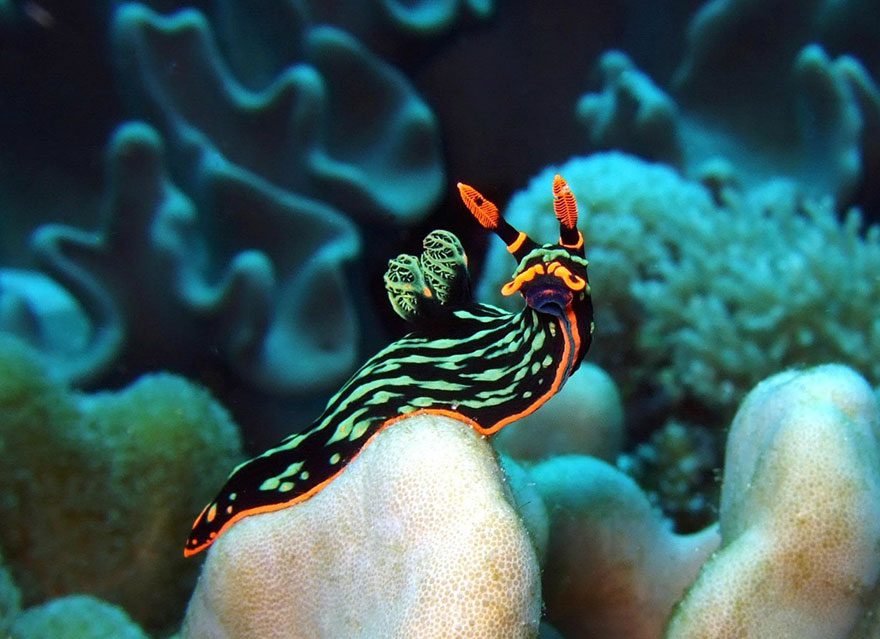
The kubaryana (sometimes called the variable neon slug) is another dorid nudibranch that can reach lengths of 120mm and is known for its green-stripes black body and orange headpieces. The kubaryana feeds on ascidians, or sea squirts, a type of invertebrate.
Antiopella Barbarensis
While this alien-looking octopus-like slug might look very similar to the Janolus fuscus, they are not actually related, a fact that biologists only recently discovered. They previously included the Antiopella barbarensis into the Janolus genus instead of the Antiopella genus.
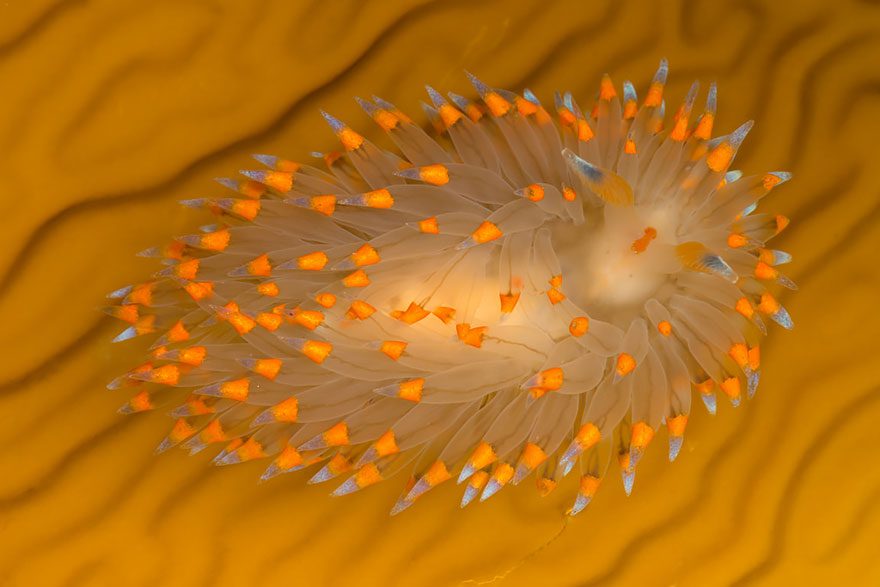
While the barbarensis might look like a massive fellow, they only reach lengths of about 50mm. Like other Antiopellas, the barbarensis feeds on moss organisms, more properly and scientifically known as Bryozoa, and likes to live in (relatively) shallow waters.
Flabellina Affinis
Yeah, we cannot decide if the Flabellina affinis is cute or creepy looking; either way, it definitely could pass as some creature from any sci-fi movie. The affinis is an aeolid nudibranch and is found in European and Atlantic waters.
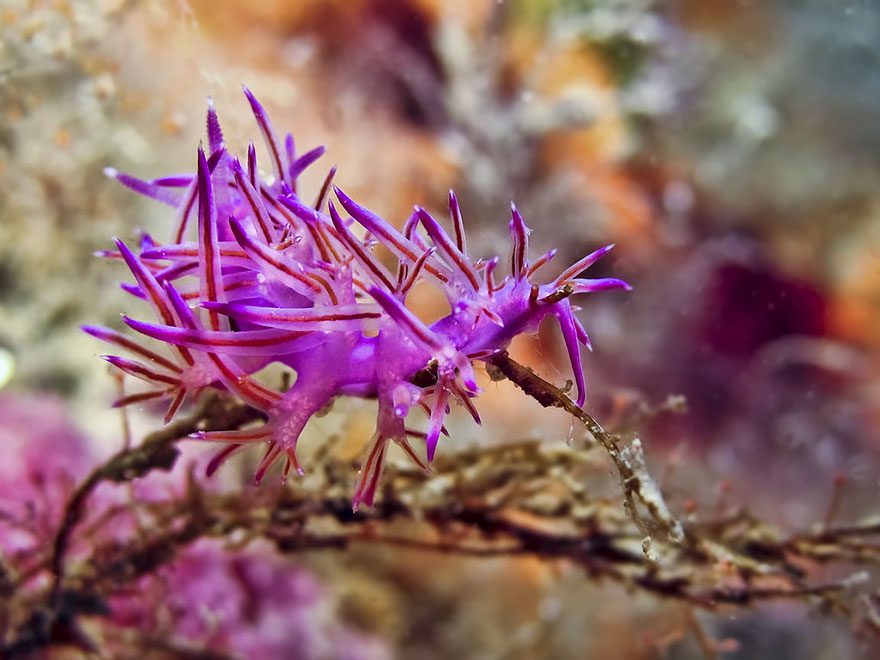
This spiky-backed critter can grow up to 50mm in length and mainly feeds on plant-like creatures known as eudenriums. Like other members of the Flabellinidae family, the affinis is truly attention-grabbing with its pale pink and purple and translucent body.
Phyllodesmium Serratum
And now, for a slightly eerie-looking one. The Phyllodesmium serratum, just like its cousin the poindimiei, looks like some secret experiment gone wrong. The serratum is an aeolid nudibranch that you can find within the waters of Japan and Australia.
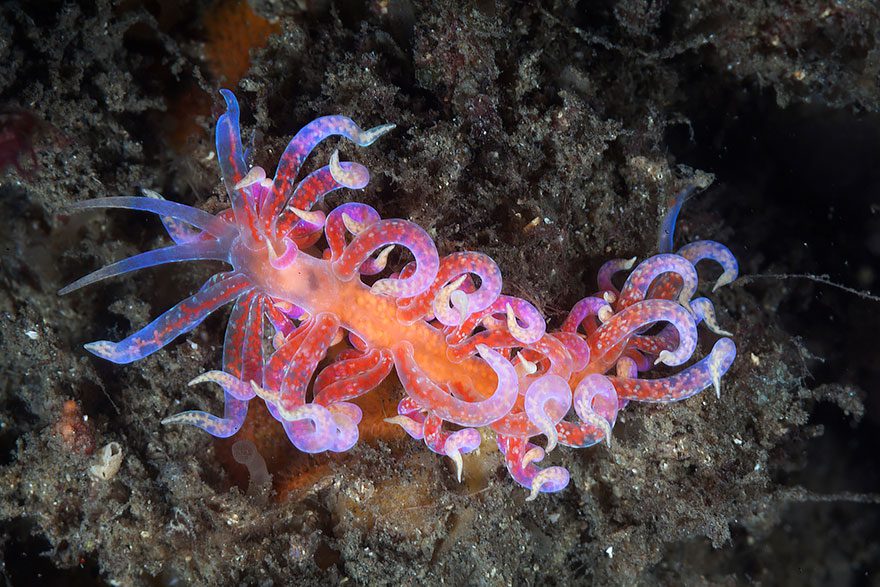
What makes the serratum fascinating is that they contain no zooxanthellae. Zooxanthellae refer to a group of single-celled photosynthetic organisms that often share a symbiotic relationship with other nudibranchs, providing their nudibranch host with a source of carbon needed to produce energy.
Goniobranchus Alius
We don’t know if the Goniobranchus alius wanted to look like a flying saucer or moldy pancake, but either way, it still manages to look cute. The alius is a dorid nudibranch found in the western parts of the Indian Ocean.
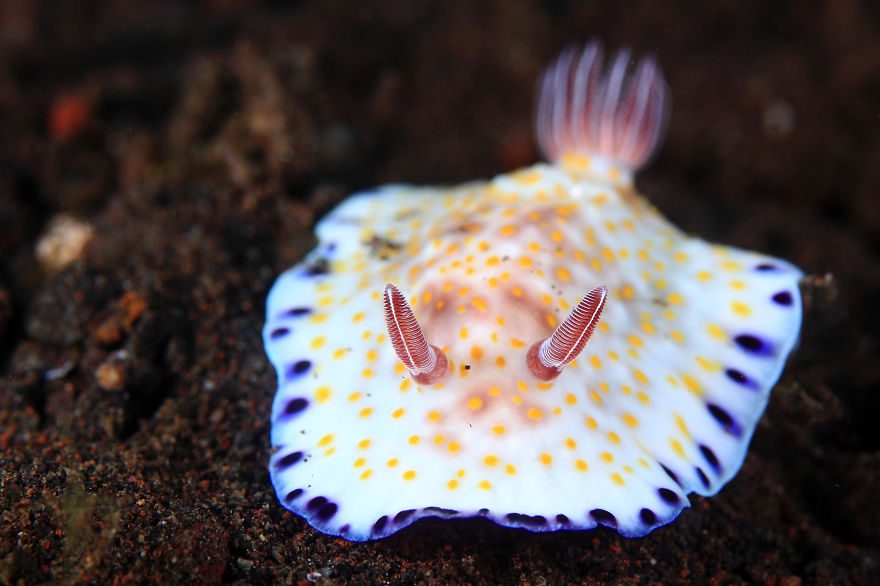
Surprisingly, there is not much known about these odd little guys besides being part of the Chromodorididae family. As a member of this species, we do know that they enjoy feeding on sea sponges. That’s a common menu item, we’ve noticed.
Hermissenda Crassicornis – Thick-Horned Nudibranch
The Hermissenda crassicornis is probably one of the most fantastic looking sea slugs with its array of bright stripes and cerata, translucent body, and not to mention those horn-like rhinophores they have. No wonder they are also known as the thick-horned nudibranch.
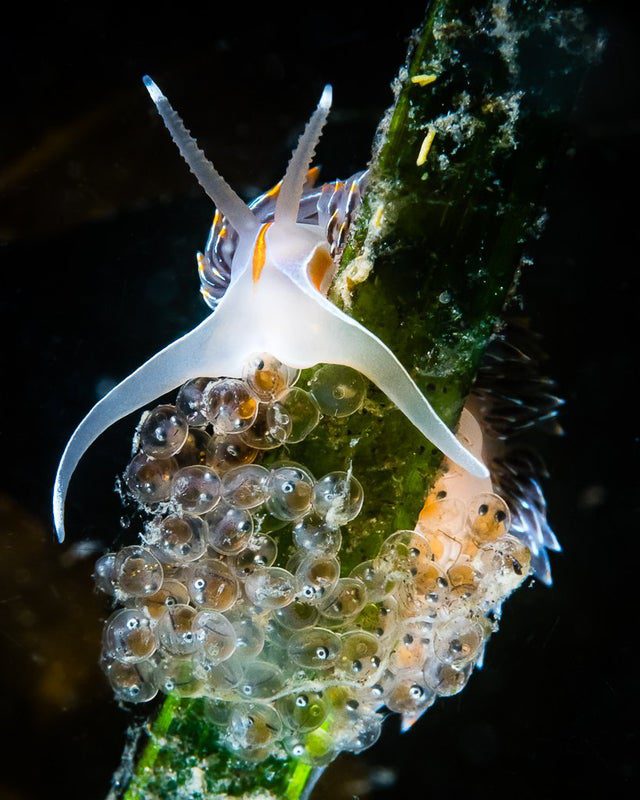
The thick-horned is quite a big fellow, capable of reaching lengths of up to 2 inches! They make their home in rocky shores and bays predominantly around Kodiak Island and Northern California. Sea anemones and sea squirts are the favored prey of the crassicornis.
The Unknown?
There is not that much information about this impressive fellow, probably because it has incorrectly been named “banyuls sec valenti” by dozens of online sites that couldn’t be bothered to do some research. That “name” mentioned above isn’t even real!
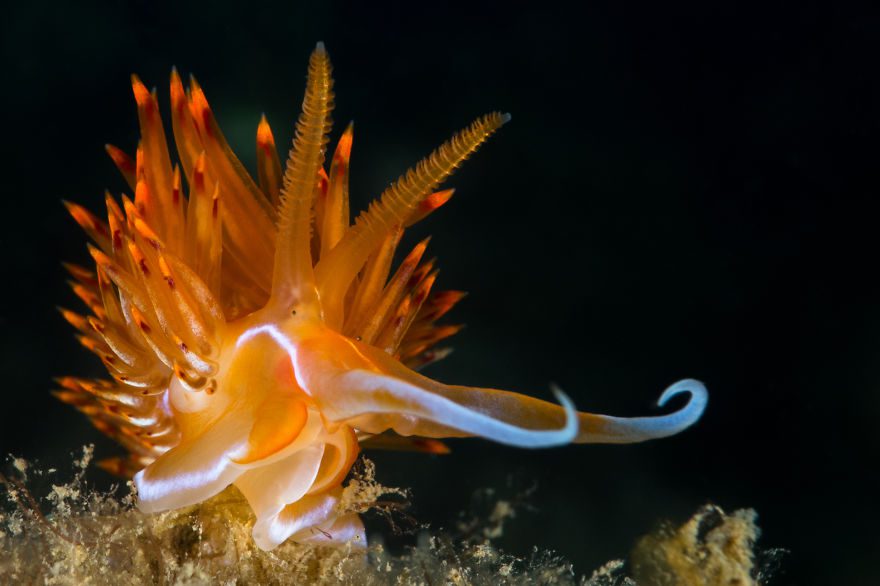
This photo was first taken by Kevin Bourdon, who simply titled the animal “sea slug” and his location being “banyuls sec valenti.” This location most likely isn’t real because the name does not show up, the only closest being Banyuls-sur-Mer in Southern France.
Hypselodoris Apolegma
This funky-looking guy is called Hypselodoris apolegma, one mouth full of a name, which is probably why it is also informally and unofficially called the purple sea slug. Apolegma is also a dorid nudibranch, so it has many cousins on our list.
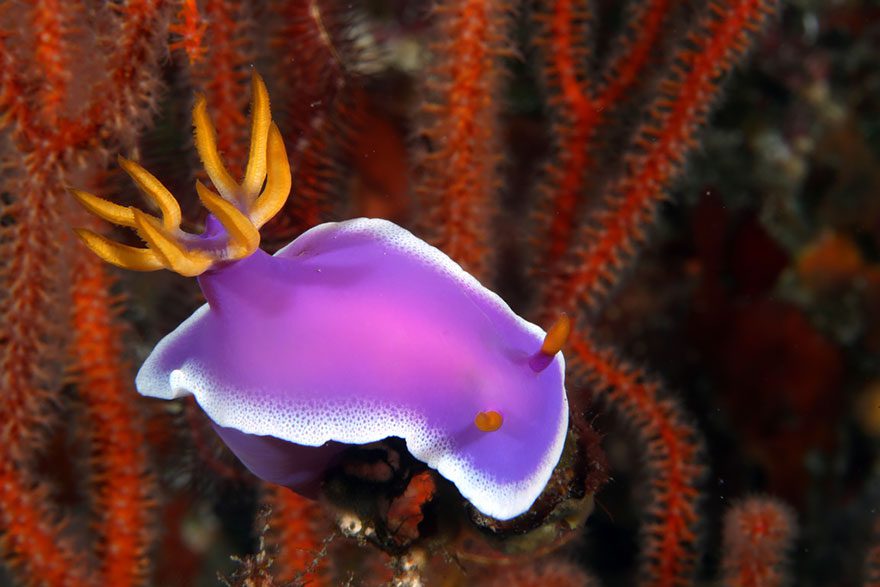
What makes dorid nudibranchs different from other nudibranchs is that they have a gill-like plume structure near their posterior. You can often find the apolegma within the tropical waters of the Western Pacific. There has been a lot of debate about which subspecies it belongs to.
Trinchesia Yamasui
Right, back to the researched sea critters! Trinchesia yamasui is an aeolid nudibranch that looks like it is either covered in little grape-like bumps or like long maggots (yuck), depending on age. Yamasui is almost exclusively found around Okinawa in Japan.
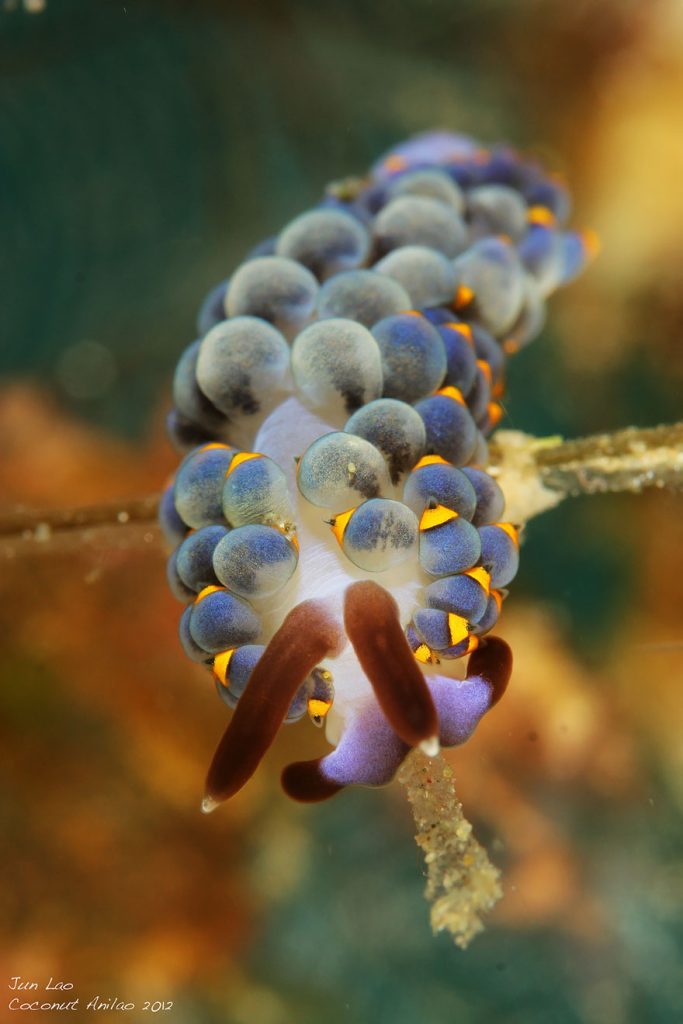
While it has been thought they were in other areas within the Indo-Pacific, it is now known that those were sea slugs of a different species. Sadly, because of language barriers, we just don’t know that much about the yamasui.
Hypselodoris Festiva
While this tiny guy might look like the Nembrotha kubaryana at first, it is actually called the Hypselodoris festiva. Common mistake! The festiva is a sponge eating dorid nudibranch commonly found along the Korea Strait (both in Korea and Japan).
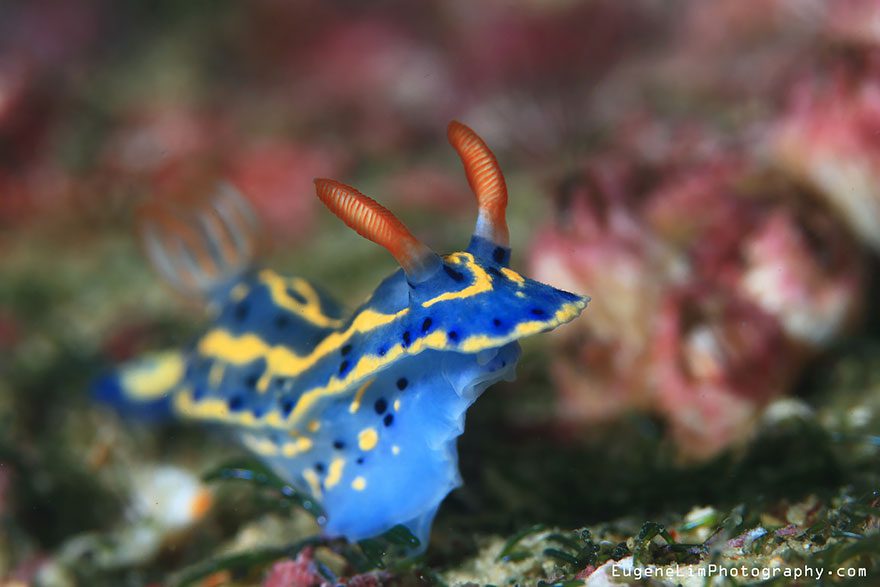
The festiva is commonly quite colorful, with a body of dark blue (boarding on a mix of teal or turquoise) accented with streaks of yellow lines and spots that cover its length and complete with red ends on its rhinophores.
Chromodoris Willani – Willan’s Chromodoris
Near the island nations of Indonesia and the Philippines, we have the Chromodoris willani, also known as Willan’s Chromodoris, a sleek blue dorid nudibranch from the Western Pacific. The willani primarily feed on various sea sponges, particularly those of the Thorectidae family.
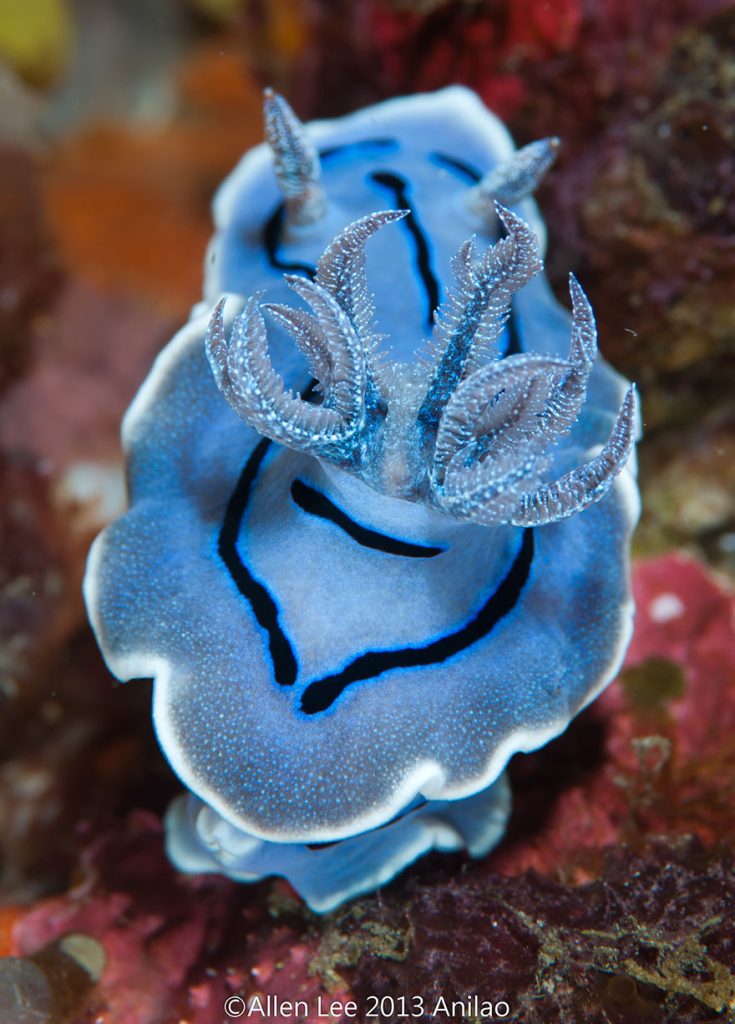
The taxonomist Dr Richard Willan first correctly documented this species, where the willani, or Willan’s Chromodoris, gets its name. Aside from that, the willani is part of the Chromodorididae family of sea slugs. This one we find particularly enchanting because of its coloring.
Doto Greenamyeri – The Donut Doto
Not too far away, nestled within the waters of Papua New Guinea through to Indonesia, lies the Doto greenamyeri, a rather bizarre-looking sea slug. The greenamyeri is a Tritonioidea nudibranch (formally a dendronotid nudibranch), a superfamily that isn’t much known.
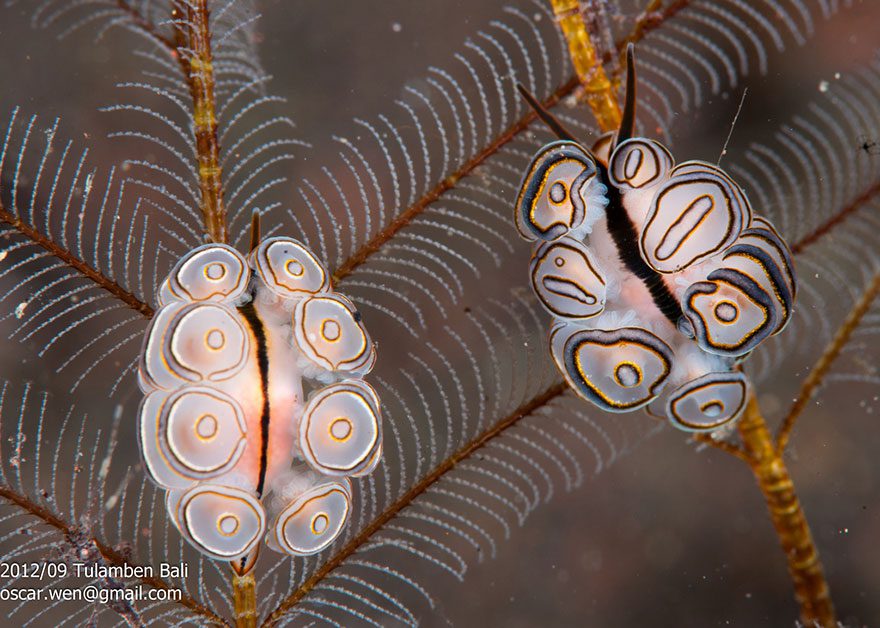
The greenamyeri (sometimes unofficially nicknamed the doughnut doto) has a pinkish translucent body and brown and black rings and stripes. It lives amongst colonies of hydroids, a living organism that you would be fooled into thinking was just an underwater plant.
Ceratosoma Amoenum – The Clown Nudibranch
The Ceratosoma amoenum is the perfect example the how complex the whole naming system can be. It often confuses people with its supposed other name Ceratosoma amoena. Amoenum is the preferred and official spelling used by the International Code of Zoological Nomenclature.
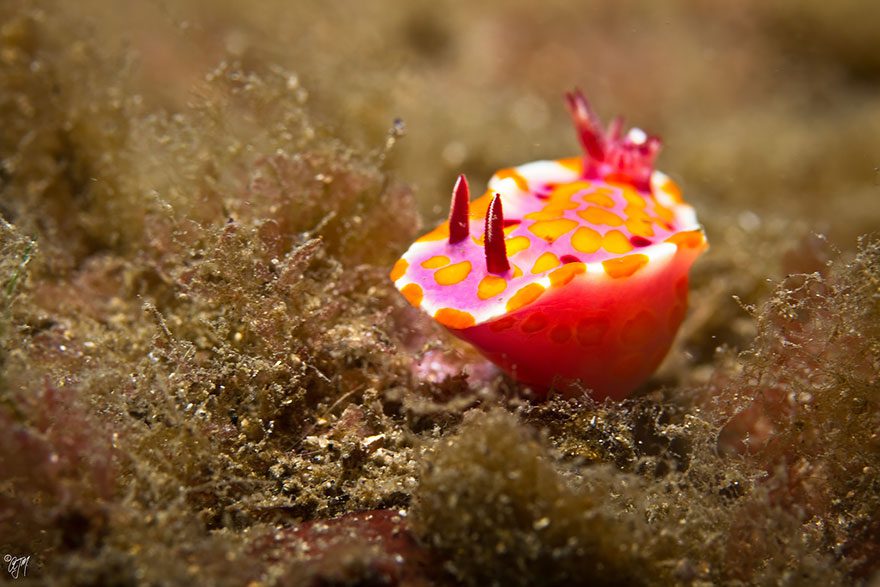
Don’t worry; you can also just call it by its nickname, the clown nudibranch, which is just s perfect name. It is very common in areas with inter-tidal waters such as New Zealand and southern Australia and can reach lengths of 60mm.
Phyllidiella Pustulosa – The Pustulose Wart slug
While the Phyllidiella pustulosa certainly is a bit odd-looking, we don’t think it deserves the really unfortunate nicknames of the pustulose wart slug or the pimpled Phyllidiella. You should be able to see why it is called this based on its appearance.
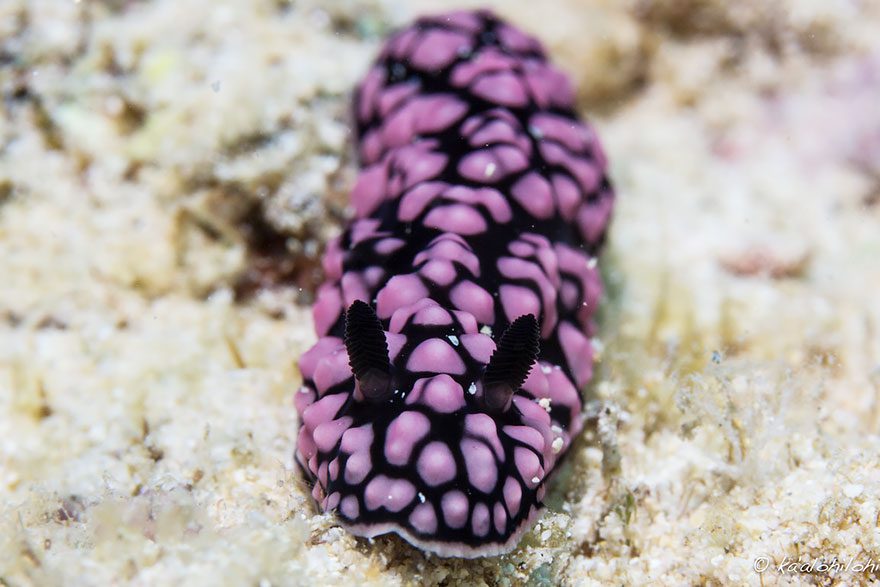
The wart slug is extremely common throughout the tropical regions of the Indo-Pacific and can reach lengths of 35mm. The slug’s body is commonly black, with the tubercles (the lumpy parts that look like pimples) changing color depending on age.
Onchidoris Bilamellata – The Rough-Mantled Doris
The Onchidoris bilamellata honestly looks like it just stepped out of a bubble bath with properly rinsing off, which is super weird considering it is commonly known as the rough-mantled doris. This could be that some look rockier than others.
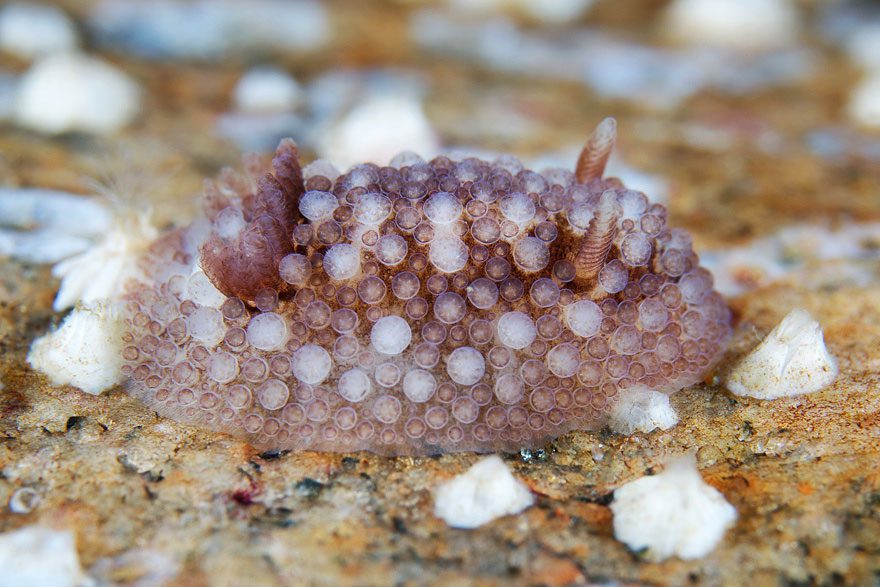
The rough-mantled is a dorid nudibranch that has been found all the way from the Norwegian Sea to the coastlines of North America. They generally have a sand or mud brown shade, with a rare few having more of a whitish color.
Hydatina Physis – The Striped Paper Bubble
Is it an opened spring roll, with a few neon-colored flowers around a shell? Nope, neither of those. We have here the Hydatina physis, which is, funnily enough, the first species of sea slug on this list that isn’t shell-less.
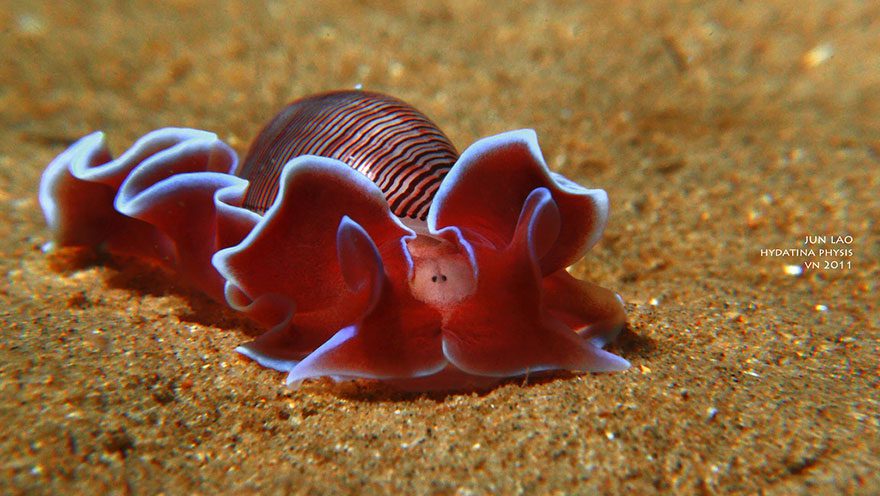
The physis, part of the Aplustridae family, goes by many names, the most fun being the striped paper bubble. The main body of the snail is safely hidden within the shell in the centre but is too big to hide the rest of its body.
Goniobranchus Albopunctatus
It looks like we have another floating pancake, only this one is more vibrant! The Goniobranchus abopunctatus (which is one ridiculously long name, in our opinion) is a dorid nudibranch from the Pacific Ocean and along the eastern coast of Africa.
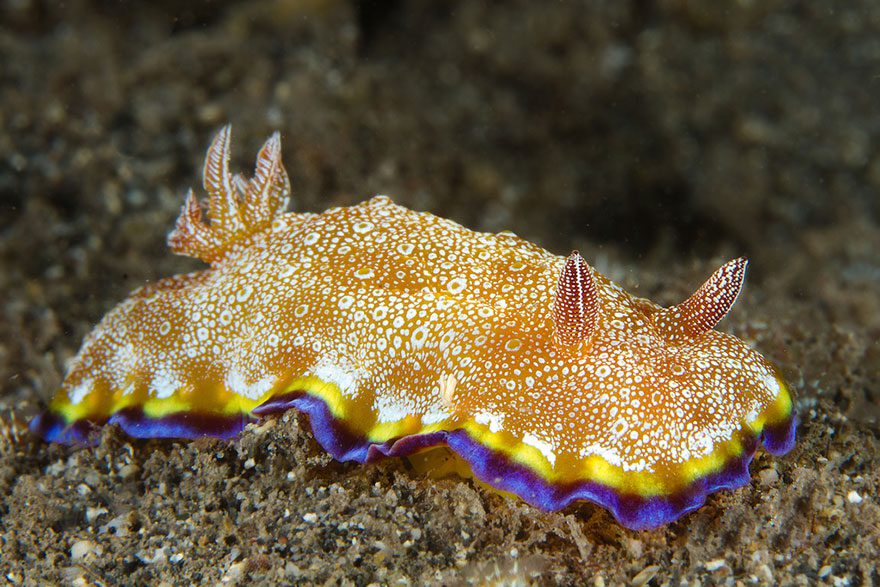
The bodies of these fellas usually have a brown and whitish pigment (hence looking like a pancake), with rings along the ends, generally one lime-green and the other a blueish hue. They also have two reddish-brown rhinophores on their heads.
Melibe Leonina – The Hooded nudibranch
There is no way the Melibe leonina is not some sort of alien jellyfish hybrid. Just look at it! The leonina, also known as the hooded nudibranch or the lion’s mane nudibranch, is from the predatory family Tethydidae. Yep, this is a hunter.
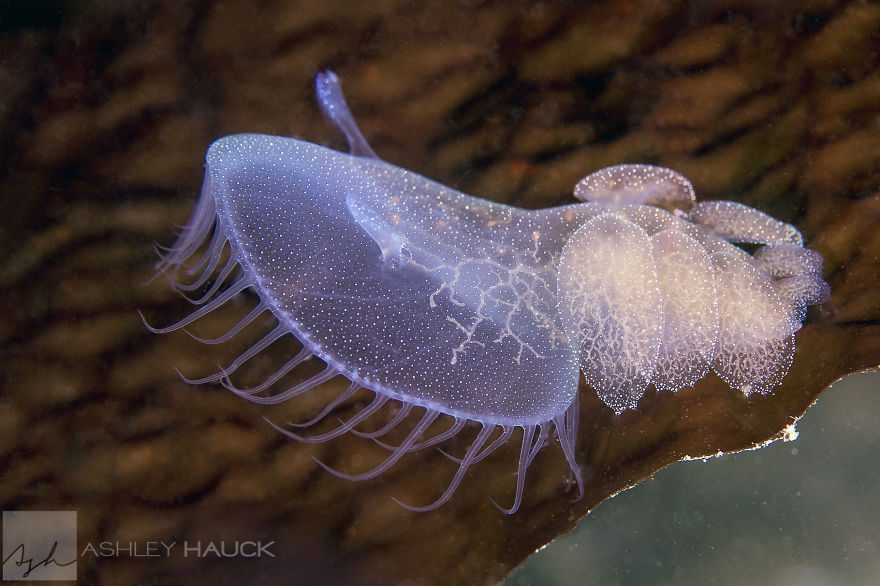
The leonina has a translucent body (100mm long and 20m wide) of various pigments (pale yellows to blues) and a large oral hood that can reach widths of 50mm and uses its rows cirri as sensory and feeding tentacles.
Ceratosoma Brevicaudatum
Ceratosoma brevicaudatum is a bit of a chubby little critter with the adorable nickname the short-tailed Certatosoma due to the short pair of cerata near its back. But don’t let the name fool you, as the short-tailed can grow up to 15cm long!
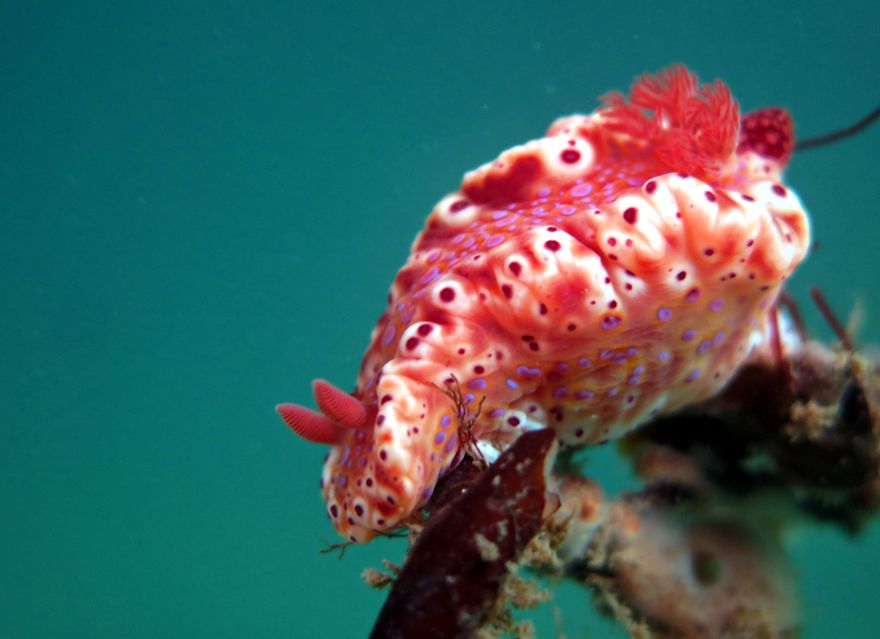
Like most sea slugs, the short-tailed feeds on sea sponges using its tiny, razor-sharp teeth. The color of the slug changes depending on where they are found, appearing in darker shades in Australian waters and in lighter shades further east.
Goniobranchus Reticulata
The Goniobranchus reticulata is a relative of the Goniobranchus abopunctatus is and found near the island of Tongatapu — the part of the Kingdom of Tonga and home to its capital city of Nuku’alofa — and debatably in many places within the Indo-Pacific.
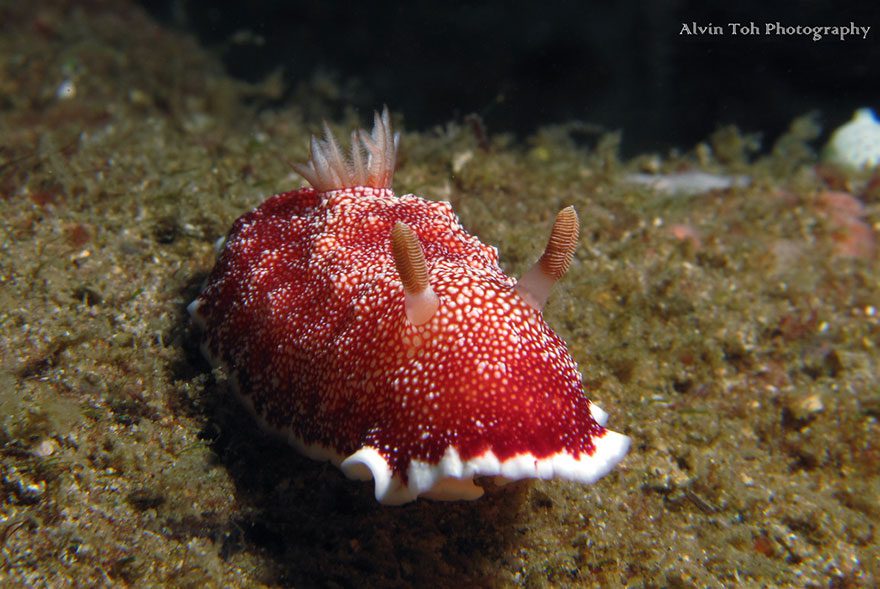
This debate of where it is found is due to disagreement among professionals and experts and whether those other sightings were of different species. The cause of the debate is because the reticulata has a bit of an inconsistent appearance.
Glaucus Atlanticus – The Blue Angel
The Glaucus atlanticus looks more like some fantastical creature from ancient mythology than an alien, which is probably why it is also known as the “blue angel,” “blue sea dragon,” and “sea swallow.” The blue angel is also a nudibranch.
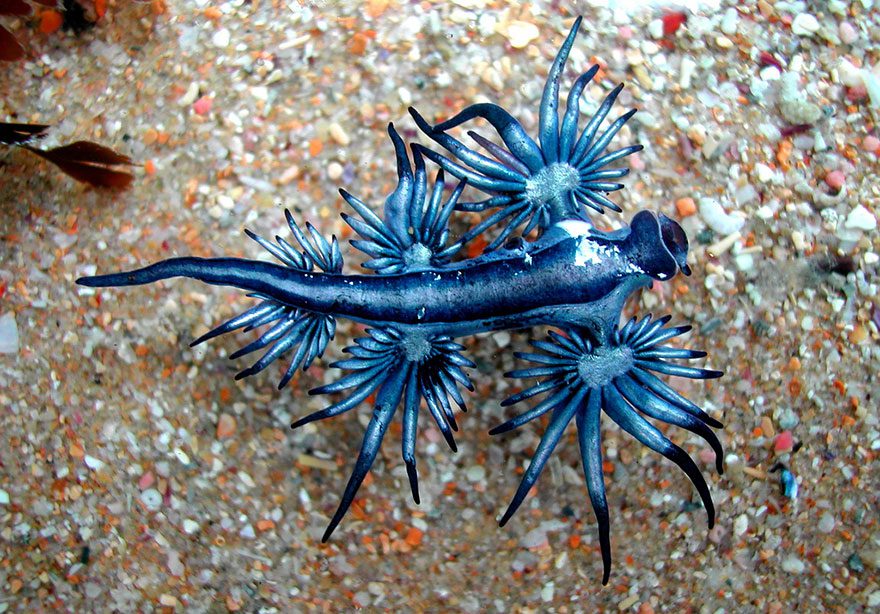
If that wasn’t cool enough, the atlanticus is a pelagic nudibranch, which means that it floats on the surface of the water upside down, allowing the current to carry it away! The atlanticus is capable of delivering an extremely painful/life-threatening jellyfish-like sting.
Phyllidia Ocellata
If you thought the Goniobranchus Alius looked moldy, you haven’t seen anything. The Phyllidia ocellata honestly looks like someone left a slab of cheese outside in the sun for about a month with its balloon-like body covered in white bubbles.
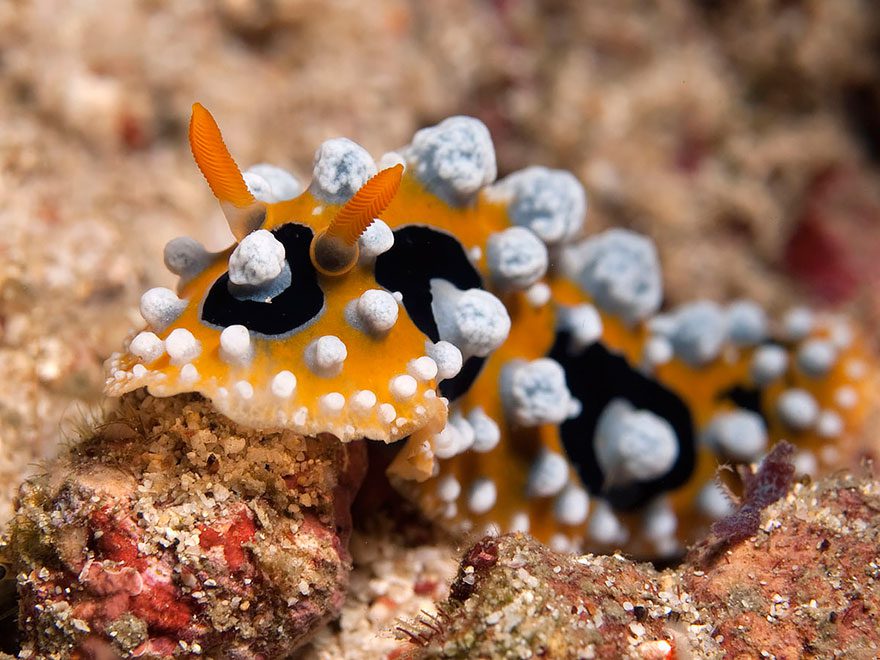
The ocellata is a dorid nudibranch often found throughout the central regions of the Indo-Pacific, commonly sighted around Indonesia, the Solomon Islands, and Malaysia. The ocellata enjoys munching on various sea sponges and can grow up to 35mm in length.
Okenia Rosacea – Hopkin’s Rose nudibranch
The Okenia rosacea (formally Hopkinsia rosacea) is a big messy looking blob that kind of lives up to its nickname, Hopkin’s Rose nudibranch, if only a bit less elegant looking. Hopkin’s Rose has often sighted the western coast of North America.
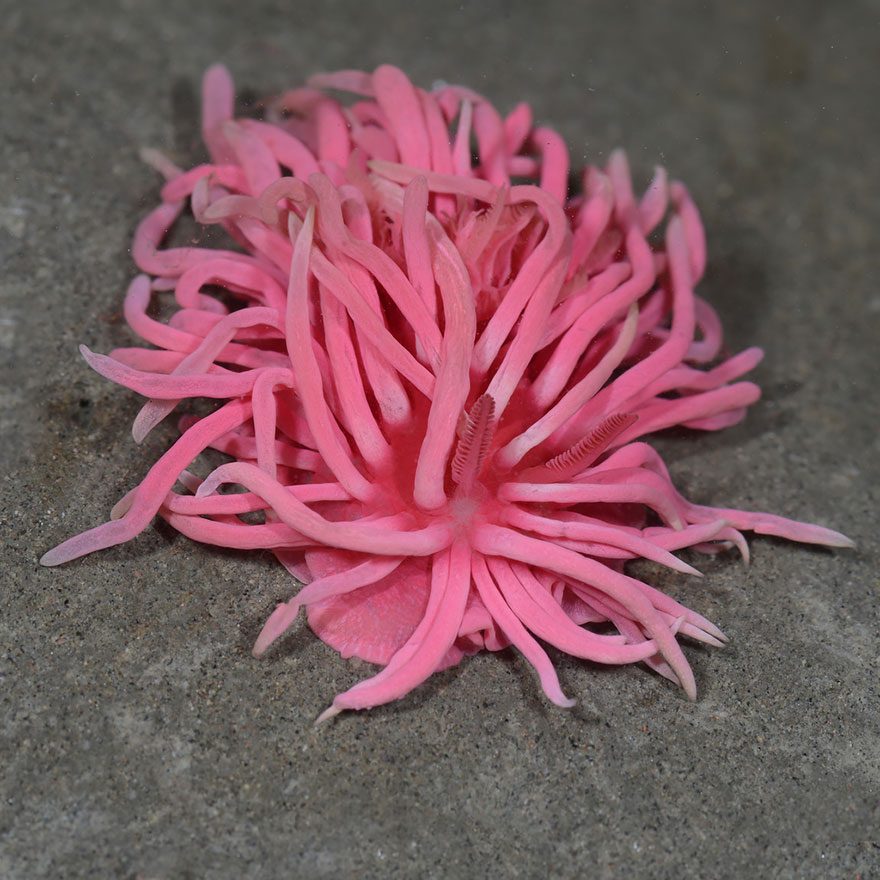
The rosacea gets its pink color from the cheilostomatous bryozoans that it feeds on, which is a kind of moss-like living (but sedentary) organism. Speaking of feeding, the rosacea has one beak-like middle tooth around rows of smaller sharp teeth.
Trinchesia Sibogae
Up next, we have the Trinchesia sibogae, an aeolid nudibranch of the Trinchesiidae family and commonly found in the tropical waters of the Indo-Pacific, with many of them located in parts of Indonesia. The sibogae was formally known as Cuthona sibogae.
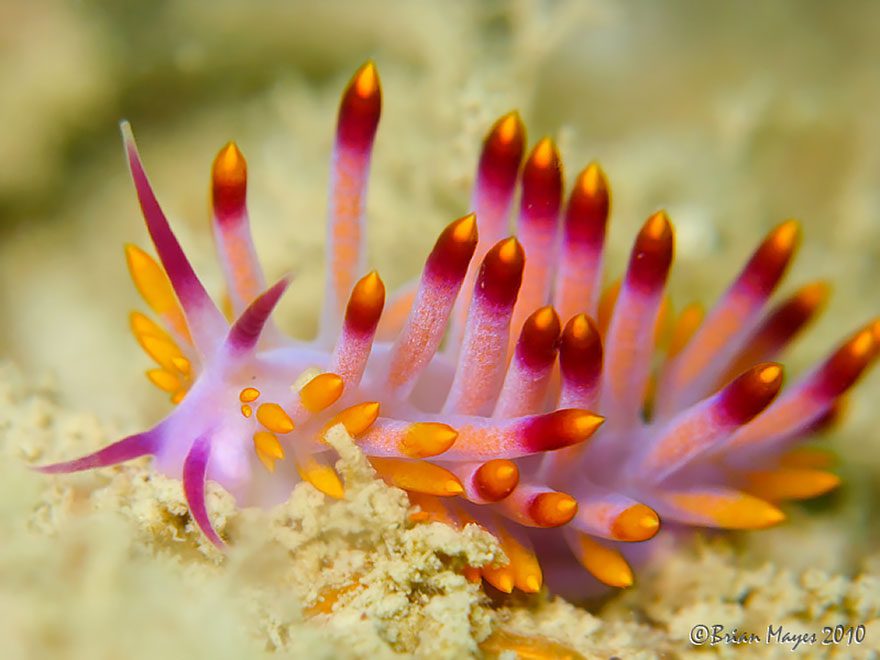
On average, the sibogae can reach lengths of 35mm, making it a large aeolid, not to mention a rather flashy one. Its body and cerata have a pink to light purple pigment, exception for the tips of the cerata, which are orange.
Bullina Lineata – The Red-Lined Bubble Snail
This little guy is not only tiny, but he is also just absolutely adorable! The Bullina lineata, or the red-lined bubble snail, is a 15-25mm long shelled sea snail part of the Aplustridae family, just like the big Hydatina Physis.
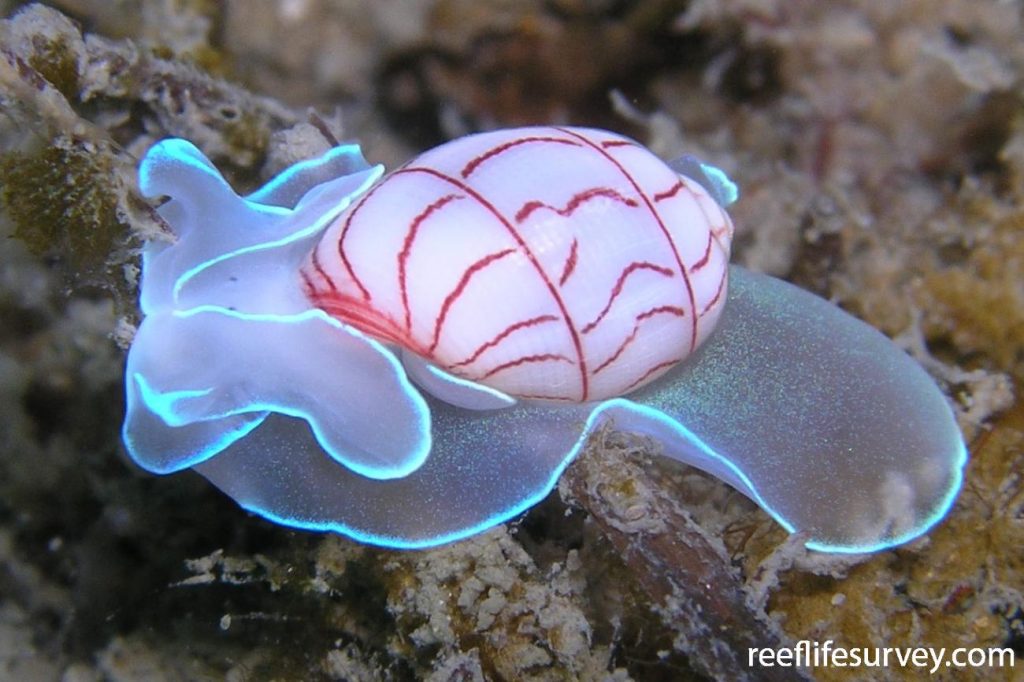
The red-lined has a largely translucent body, save for its head which has a pale white, and its edges, which shine blue! The snail gets its name from the series of red lines and spirals that decorate its white shell.
Mexichromis Multituberculata
Not sure why, but something about the Mexichromis multituberculata is reminiscent of some creeping lizard, maybe because of its horn-like rhinophores. To make things even more confusing, its name has nothing to do with Mexico as it is actually from the Indo-Pacific.
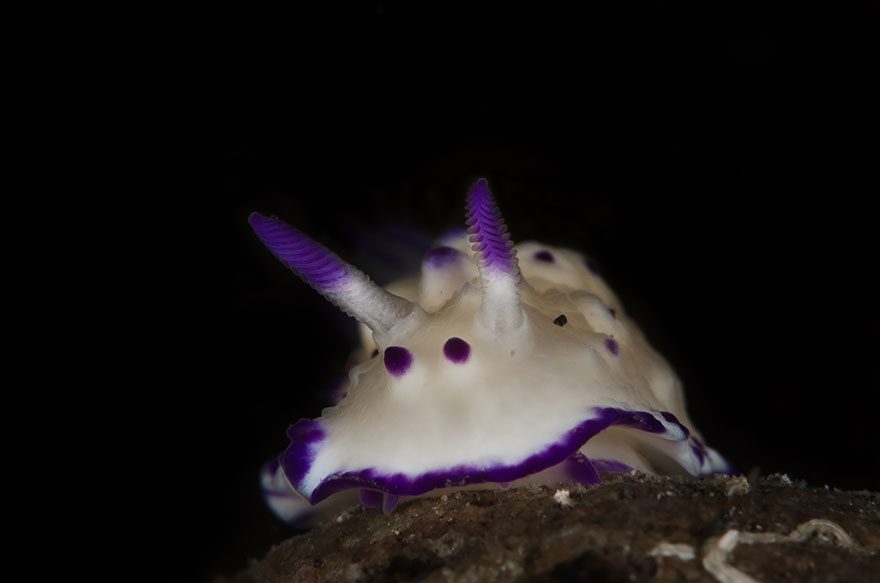
The multituberculata is believed to be found in parts of Japan, Hong Kong, Indonesia and even as far as Egypt. Due to similar appearances, it is often confused with its relative, the Mexichromis katalexis, and often feed together on the same sea sponges.
Marionia Platyctenea
Not much is known (at least outside of the scientific community) about the Marionia platyctenea, a tiny dendronotid/tritonioidea nudibranch usually found in Australian waters. But seeing as it is a member of the Tritoniidae family, we know they prefer to eat corals (specifically, octocorals).
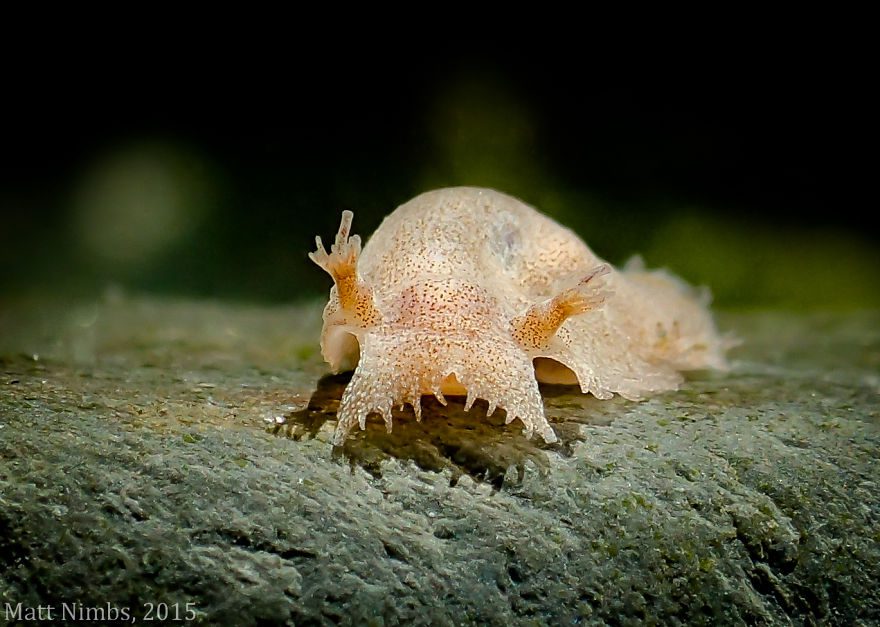
The platyctenea is undoubtedly interesting looking, with a body that is not really translucent but has a grainy texture that makes it look like a moving piece of sea sand. Its two rhinophores also look just like two small waving hands.
Goniobranchus Sinensis
No, that’s not jam covered pancake, that the Goniobranchus sinensis a tiny dorid nudibranch from the Chromodorididae family. This quirky nudibranch grows up to 20mm in length and is often found around places like Indonesia, Japan, and other neighboring islands.
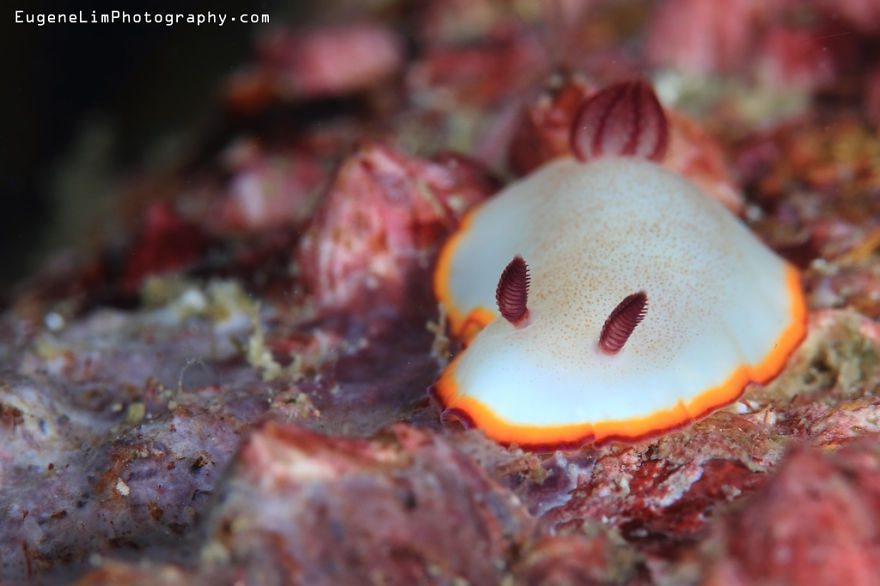
The majority of the sinensis’ body is milky-white, while the edges of its body are a mix of orange and red. But its most notable features are its bright cherry red gills, or cerata, and rhinophores that make it stand out.
Chromodoris Strigata
The wonderful Chromodoris strigata also called the streaked Chromodoris, is a vibrant dorid nudibranch again from the Chromodorididae family. The streaked Chromodoris is also quite the little traveler, found from Madagascar all the way down to Australia’s Great Barrier Reef.
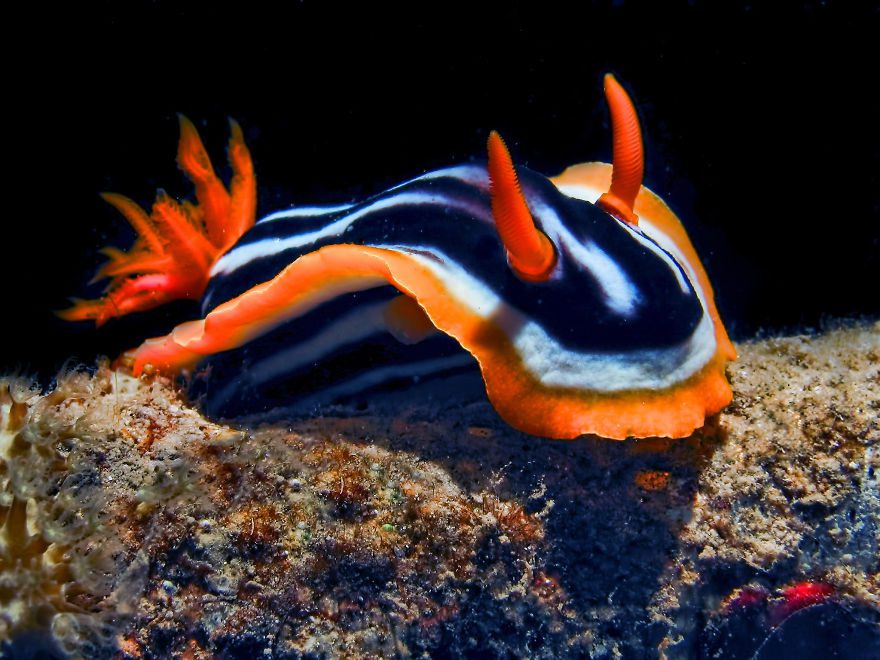
The Strigata is identified by their mix of white/pale blue and black coloring covering most of its body and the orange to the yellow hue of their rhinophores, edges, and gills. They enjoy eating sea sponges, especially those from the Darwinellidae family.
Phyllodesmium Opalescens
Looks like we have another octopoid looking visitor. Phyllodesmium opalescens is an aeolid nudibranch that you can usually find chilling around the waters of Korea and the Philippines. This is another sea snail we just don’t know that much about.
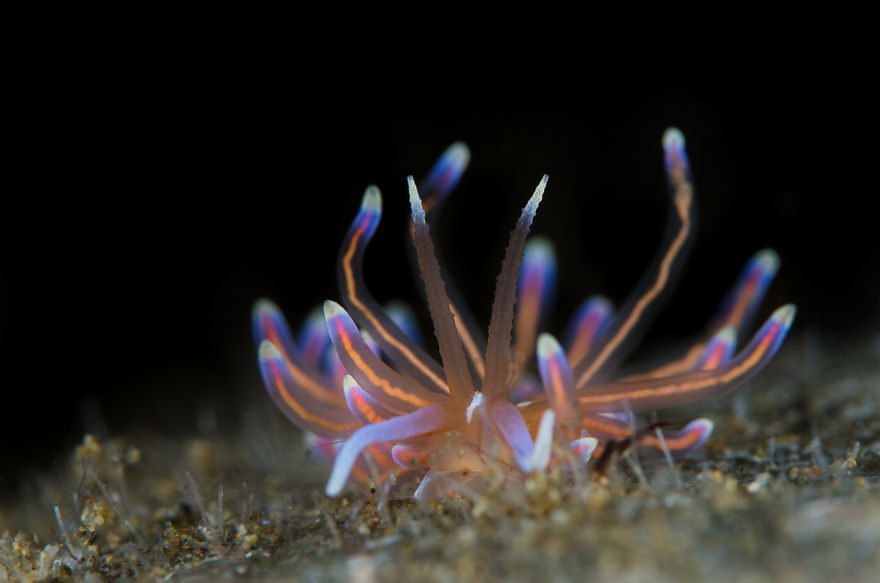
Experts don’t even know what it generally eats! These 20mm long glow lights have a near translucent body with strips of blue and orange that run along and color the tips of their hovering cerata that decorate their beautiful bodies.
Acanthodoris Lutea – The Orange-Peel Doris
The Acanthodoris lutea, perfectly nicknamed the orange-peel doris, is an attention-grabbing nudibranch from the Onchidorididae family, of which it is one of the largest species within the family. The orange peel can reach lengths of up to 30cm when fully grown!
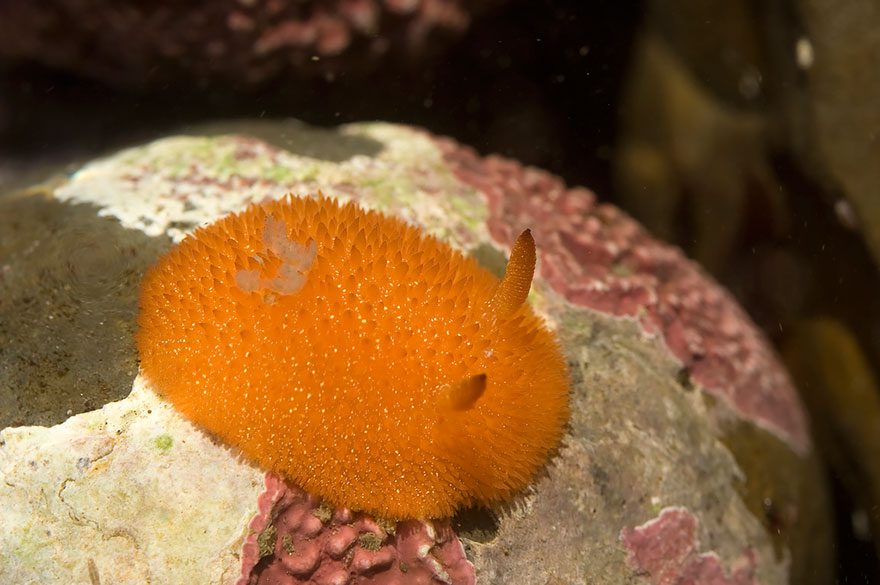
The lutea generally has a rich orange or light-yellow coloring, with the whole body covered in tiny spiky things that are probably cerata. Interesting facts, the lutea is said to smell of sandalwood when out of the water. Now, that’s odd!
Peltodoris Atromaculata – The Dotted Sea Slug
The Peltodoris atromaculata, another sea slug that perfectly lives up to its nicknames, the dotted sea slug and the sea cow (not to be confused with manatees). The sea cow can only be found in the waters of the Mediterranean Sea.
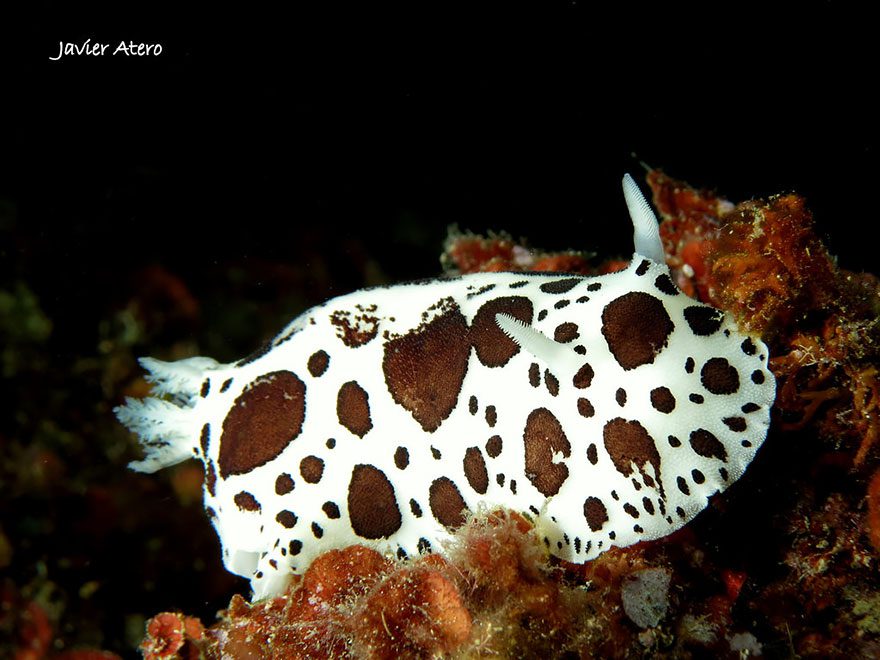
They generally reach lengths of up to 7cm and can live for around 15 months, but it has been reported they sometimes die a couple of weeks following reproduction. The atromaculata only feeds on the sea sponges Petrosia ficiforms and Haliclona fulva.
Elysia Crispata – Lettuce Sea Snail
We have the Elysia crispata, also otherwise known as the lettuce sea slug, which is probably the most poetic name so far. It is a member of the Sacoglossan order, just like the leaf sheep snail and the Cyerce nigricans.
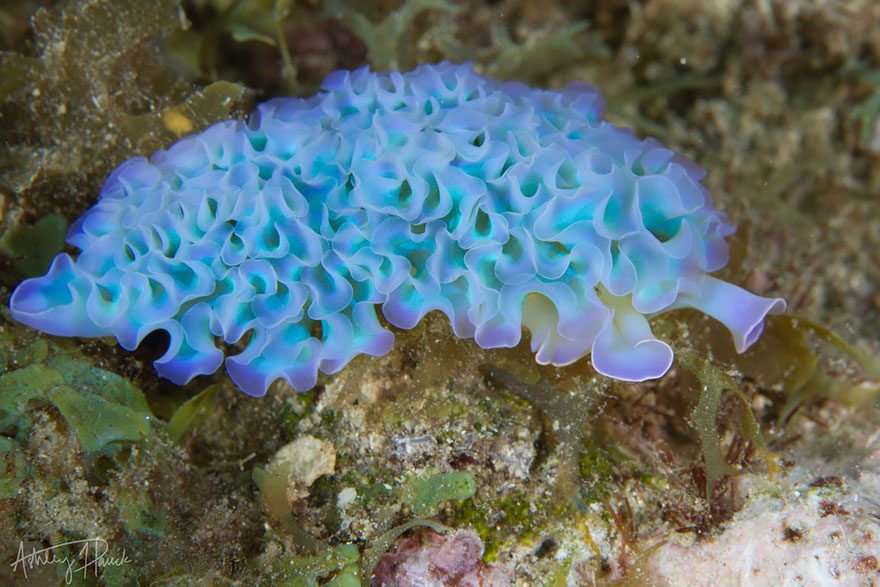
This means that the crispata also generates energy by feeding on photosynthesis organisms like algae. But unlike other Sacoglossans that only eat a particular type of algae, the lettuce snail is not so peaky, meaning it is better poised for survival.
Doriprismatica Atromarginata
Think we see a trend here; a couple of these snails look like vegetables, including the Doriprismatica atromarginata that honestly looks like some cauliflower. This fella is a dorid nudibranch, part of the Chromodorididae family, commonly found in the Indo-Pacific region.
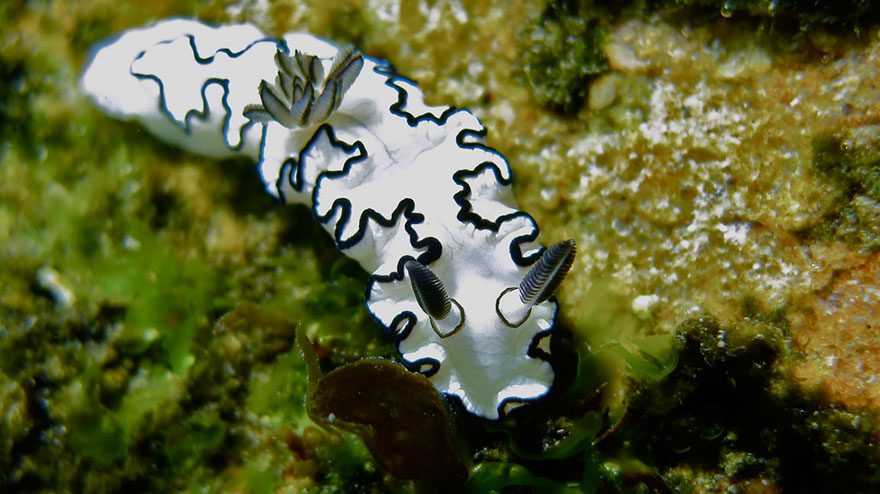
The atromarginata has a fluffy appearing white to yellowish body and black lines covering the edges of its mantle and rhinophore clubs (which are just like stalk rhinophores, only more boxlike). Atromarginatas feed on sea sponges just like other nudibranchs.
Costasiella Kuroshimae – The Leaf Sheep
Costasiella kuroshimae, adorably nicknamed the “leaf sheep” or “lead slug,” is probably one of the cutest things you will ever see! The leaf sheep is part of the Sacoglossan family, a group of sea snails slugs that live on solar power.
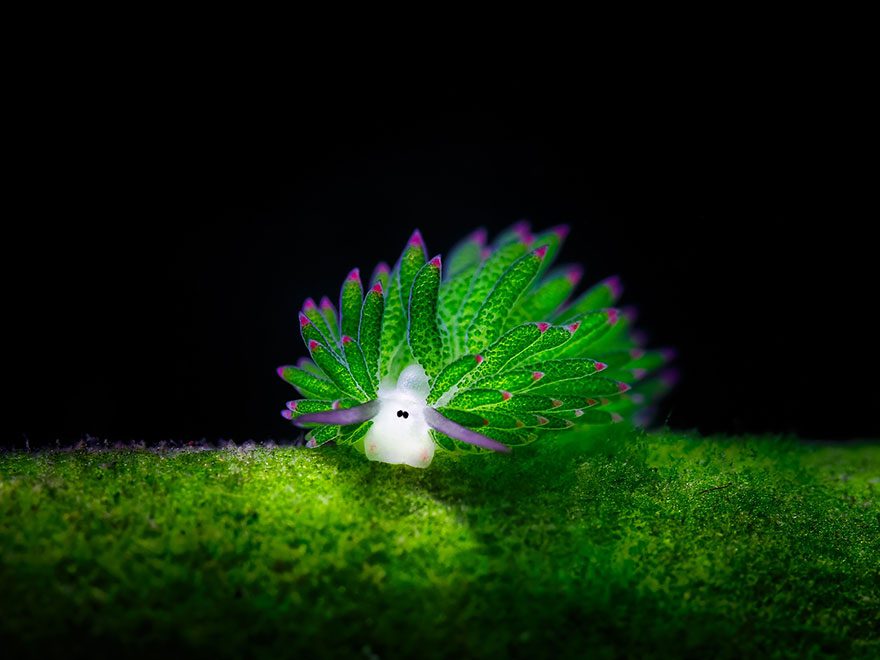
Kind of. The leaf sheep sucks a cellular fluid from nearby clumps of algae, using the chloroplasts (an organism used for photosynthesis) from the algae they eat, basically living on sun rays. It is found in the Philippines and Japan.
Janolus Savinkini – The Purple-Tipped Janolus
The Janolus genus really knows how to make a statement, the fact that the Janolus savinkiki perfectly reaffirms with its deep yellow that covers its whole body, save for the dozens of cerata tips which are purplish and white, or sometimes yellow.
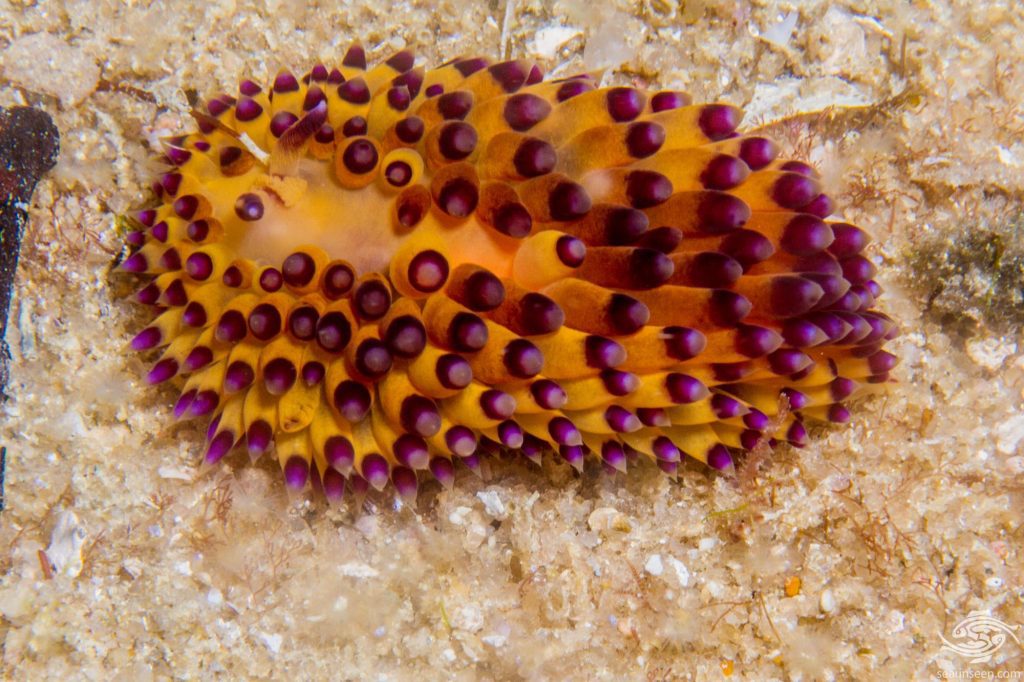
No wonder it is commonly known as the purple-tipped Janolus. This species can usually be found in the shallow waters of East Asia, where it feeds on areas rich with algae and stinging celled hydroids (related to coral and jellyfish)
Elysia Chlorotica – Eastern Emerald Elysia
Lastly, we have the eastern emerald Elysia, a magical name that is just as pleasant to read as its official scientific name, the Elysia chlorotica. The emerald Elysia is another Sacoglossa, as you can probably guess by its plant-like appearance.
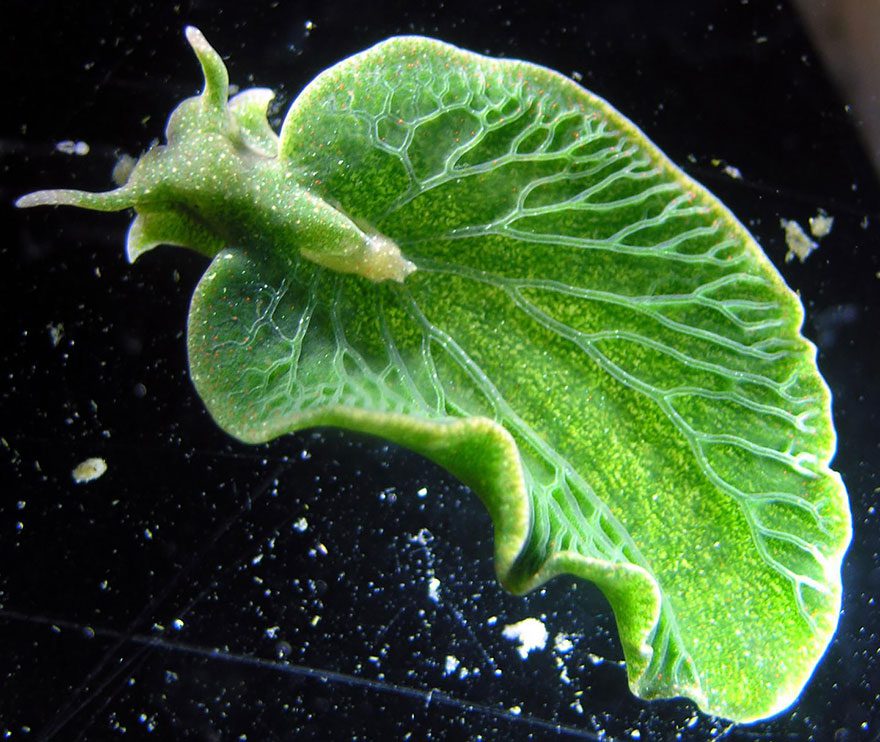
Like most other Sacoglossa, the emerald Elysia feeds off and sucks the nutrients and chloroplasts from algae organisms, allowing photosynthesis. The chlorotica makes it home in the waters of the eastern coast of the United States’ all the way up to Canada.
